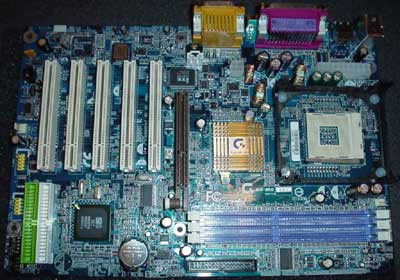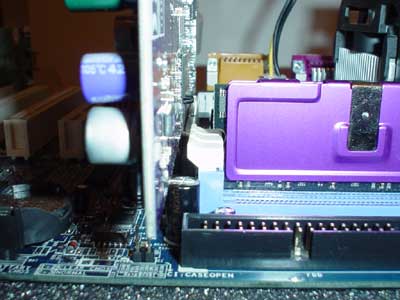
Original Link: https://www.anandtech.com/show/995
Gigabyte 8SG667 (SiS 648): Big Power in a Small Package
by Evan Lieb on September 17, 2002 2:19 AM EST- Posted in
- Motherboards
 During
most of this summer we have gained quite a bit of experience with SiS 648-powered
motherboards; these include Shuttle's
AS45GTR, ABIT's
SR7-8X, MSI's
648 Max-F, and of course SiS's
own 648 reference motherboard. The Gigabyte 8SG667 we're putting to the
test today is the fourth retail SiS 648 motherboard we've tested in the past
six weeks. And in just six weeks since the first SiS 648 motherboard hit the
market (Shuttle's AS45GTR), we've seen quite substantial improvement in not
only performance but reliability as well (especially DDR400 reliability). While
every single one of the SiS 648 motherboards we've tested have performed and
operated seamlessly at DDR333 speeds, DDR400 functionality has been another
story altogether. Some of the quirks at DDR400 settings are quite understandable
though, since DDR400 has yet to be validated as a spec by the Joint Electron
Device Engineering Counsel (JEDEC).
During
most of this summer we have gained quite a bit of experience with SiS 648-powered
motherboards; these include Shuttle's
AS45GTR, ABIT's
SR7-8X, MSI's
648 Max-F, and of course SiS's
own 648 reference motherboard. The Gigabyte 8SG667 we're putting to the
test today is the fourth retail SiS 648 motherboard we've tested in the past
six weeks. And in just six weeks since the first SiS 648 motherboard hit the
market (Shuttle's AS45GTR), we've seen quite substantial improvement in not
only performance but reliability as well (especially DDR400 reliability). While
every single one of the SiS 648 motherboards we've tested have performed and
operated seamlessly at DDR333 speeds, DDR400 functionality has been another
story altogether. Some of the quirks at DDR400 settings are quite understandable
though, since DDR400 has yet to be validated as a spec by the Joint Electron
Device Engineering Counsel (JEDEC).
Despite some of the minor issues with DDR400 and certain 648 motherboards, SiS's 648 chipset has nonetheless gained the respect of a lot of system integrators, mostly those looking for a low-cost, high-performance solution.
Gigabyte's 8SG667 motherboard will certainly not disappoint those looking for such a setup. Find out why there's a lot more to this product than you think…
Gigabyte 8SG667: Basic Features
|
Motherboard Specifications |
|
|
CPU
Interface
|
Socket-478
|
|
Chipset
|
SiS
648 North Bridge
SiS 963 South Bridge |
|
Bus
Speeds
|
100 - 355MHz (in 1MHz increments)
|
|
Core
Voltages Supported
|
N/A
|
|
I/O
Voltages Supported
|
N/A
|
|
DRAM
Voltages Supported
|
N/A
|
|
Memory
Slots
|
3
184-pin DDR DIMM Slots
|
|
Expansion
Slots
|
1
AGP 8X Slot
5 PCI Slots |
|
Onboard
RAID
|
N/A
|
|
Onboard
USB 2.0/IEEE-1394
|
USB2
Supported through South Bridge
No IEEE-1394 |
|
Onboard
LAN
|
N/A
|
|
Onboard
Audio
|
Realtek
ALC650 6-channel AC'97
|
|
BIOS
Version Tested
|
F3e
|
The Gigabyte 8SG667 isn't all that feature-rich of a motherboard. There's no RAID controller, no LAN, and no FireWire to be found anywhere.
The features that Gigabyte does decide to throw in with this board include onboard sound in the form of the Realtek ALC650 chip.
As with all SiS 648 motherboards, there's native onboard USB 2.0 support. The Gigabyte 8SG667 offers 2 rear USB 2.0 ports for your pleasure.
The I/O ports are nothing special either, offering the usual set of features; 2 PS/2 ports, 2 serial ports, one parallel port, and a Game port (where you can activate the onboard sound if you desire).
Thankfully, there's plenty of room for expansion with 5 onboard PCI slots available to the user. In addition, there are 3 DIMM slots available, supporting up to 3GB of DDR DRAM. One of most attractive features this motherboard offers is unofficial support for DDR400 memory. We'll get into DDR400 a little later…
The Gigabyte 8SG667, unfortunately, doesn't come with a dual BIOS setup like most of Gigabyte's other motherboards. Despite the small size of the board, it would have been nice to see a backup BIOS anyway.
That's about it feature-wise. However, we do see a possibility for onboard LAN with this motherboard; if you look closely you can see the solder pads for a Realtek 8100B chip. It's not all that unlikely that we'll see a version of the Gigabyte 8SG667 with onboard LAN in the future.
Board Layout
The Gigabyte 8SG667 doesn't employ all that interesting of a layout. However, we did have some complaints.
First off, the ATX 20-pin connector shouldn't be located so close to the I/O panel. As we've mentioned countless times in the past, it's generally a bad idea for motherboard makers to place the ATX connector on the left-hand side of the motherboard, because the main ATX power lines completely block a user from installing/uninstalling the CPU HSF, or at the very least makes it difficult. In addition, the way Gigabyte placed the ATX connector restricts air flow a bit, which is never a good thing for your hardware.
We would also like to have seen the ATX12V connector placed somewhere else besides next to the I/O ports; however we rarely see motherboard makers position the ATX12V connector on the right-hand portion of the motherboard anyway, so we won't hold our breath for this to be corrected in the future.
Yet another layout annoyance with the 8SG667 is the placement of the DIMM connectors so very close to the AGP 8X slot. It was very difficult to unhinge memory with a GeForce4 Ti4600 installed, as this video card is big enough to block all 3 DIMM connectors from unlocking completely. However, a GeForce3 Ti200 is small enough to block only one of the DIMM connectors, so only GeForce4 users should be worried about the tight space between their video card and the DIMM slots.
All 5 PCI slots were laid out in such a way so that there wasn't any real significant trouble in installing different types of PCI cards (sound cards, network cards, etc.). However, with an ASUS GeForce4 Ti4600 installed, it was somewhat difficult to get certain PCI cards to fit in the 1st PCI slot (the one closest to the AGP slot). However, this isn't uncommon with other SiS 648 motherboards on the market, like the ABIT SR7-8X for example. Using a GeForce3 Ti200 didn't change our issues with the 1st PCI slot, but a GeForce2 MX400 was able to fit, clearly because the heatsink required is smaller.
BIOS and Overclocking
Gigabyte decided to go with the Award BIOS for this particular motherboard. There are some pretty nifty BIOS features and overclocking options that come with this motherboard, although they're not all that amazing.
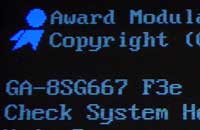 First
off, we were disappointed to see that the PC Health section of the Award BIOS
offered virtually nothing in the way of information. The only feature we were
able to spot in PC Health was FAN RPM speed. There were no CPU temperature readings,
case readings, or even PSU readings. However, Gigabyte tells us that 8SG667
boards will ship with a different BIOS version than the one we used (F3e) that
will offer all the readings we desire.
First
off, we were disappointed to see that the PC Health section of the Award BIOS
offered virtually nothing in the way of information. The only feature we were
able to spot in PC Health was FAN RPM speed. There were no CPU temperature readings,
case readings, or even PSU readings. However, Gigabyte tells us that 8SG667
boards will ship with a different BIOS version than the one we used (F3e) that
will offer all the readings we desire.
As far as overclocking options are concerned, there's some good and bad to report. The bad is that there are absolutely no VDIMM, Vcore, or AGP voltage adjustments available via the Award BIOS. In fact, there aren't any onboard jumpers that allow voltage or frequency adjustments either. However, Gigabyte claims the next (i.e. shipping) BIOS will have these frequency and voltage adjustments available (no jumpers though. :)).
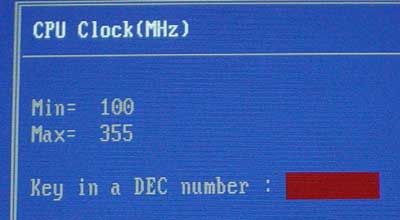
The good part about this board as far as overclocking options are concerned is an adjustable FSB all the way up to 355MHz, which is ridiculously high, but quite a mouthwatering potential speed nonetheless.

Thankfully, there's also an AGP/PCI lock option, which allows you to keep your AGP/PCI devices running at their defaults speeds. For some reason, Gigabyte thought that it would be a good idea to include an option for raising AGP frequency up to 255MHz. Can you say overkill?
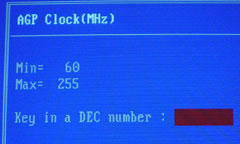
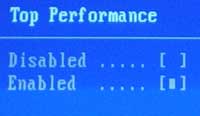 There's
also a "Top Performance" option in the BIOS, which optimizes the memory controller in the North Bridge for the best
performance possible (at a stable rate). So all enabling Top Performance speed up the internal timings of the memory controller. We have also been told by Gigabyte that even though we have no way of knowing voltages for our CPU
and memory, they're set to their default values (1.5Vcore for Pentium 4 and
2.5/2.6V for DDR DRAM). This is very likely true, and so one would think that
a substantial overclock would be hard to come by. Well, we're happy to report
that the Gigabyte 8SG667 overclocks exceptionally well. The 8SG667 was able
to operate seamlessly at ~ 2.56GHz, or 150MHz FSB. This is well over a 300MHz
overclock, using an everyday retail heatsink and fan (and thermal pad) from
Intel, and all on 1.5Vcore. If you ask us this is quite an impressive feat.
There's
also a "Top Performance" option in the BIOS, which optimizes the memory controller in the North Bridge for the best
performance possible (at a stable rate). So all enabling Top Performance speed up the internal timings of the memory controller. We have also been told by Gigabyte that even though we have no way of knowing voltages for our CPU
and memory, they're set to their default values (1.5Vcore for Pentium 4 and
2.5/2.6V for DDR DRAM). This is very likely true, and so one would think that
a substantial overclock would be hard to come by. Well, we're happy to report
that the Gigabyte 8SG667 overclocks exceptionally well. The 8SG667 was able
to operate seamlessly at ~ 2.56GHz, or 150MHz FSB. This is well over a 300MHz
overclock, using an everyday retail heatsink and fan (and thermal pad) from
Intel, and all on 1.5Vcore. If you ask us this is quite an impressive feat.
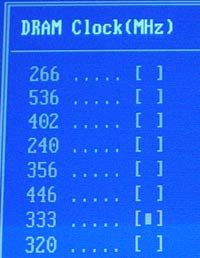
We also did a little memory overclocking this time around. We were able to get our Mushkin DDR400 memory up to 422MHz reliably, on the assumed default 2.5/2.6V.

Mushkin's DDR400 modules worked at speeds of up to 422MHz on the Gigabyte board.
In this next section we'll talk about how the Gigabyte 8SG667 held up under intense CPU, memory, and general system stability tests…
Stress Testing the Gigabyte 8SG667 and The Test…
We performed our usual array of stress tests on the Gigabyte 8SG667 for this review, but added some more memory tests this time around.
We started off by stress testing memory first. With all 3 DIMM slots filled with single-sided DDR333 memory from Kingston (CL2.5, 256MB), we were easily able to run Prime95 torture tests for approximately 24 hours without a hitch. Most people would be quite happy with this outcome, but that's hardly all the 8SG667 was capable of.
Having already completed all the DDR400 benchmarks necessary for this review, we knew the Gigabyte 8SG667 was a fine option for DDR400 operation. However, this scenario only held true with one DIMM slot full at that point. Therefore, we proceeded to move onto more intensive memory situations, and so we inserted two sticks of Mushkin DDR400 memory into banks 1 and 2. We watched as it completed not only our entire benchmark suite twice over, but also 48 hours of Prime95 torture tests. This was definitely not possible with the ABIT SR7-8X or MSI 648 Max-F. While ABIT and MSI's SiS 648 motherboards were reliable (for the most part) with one DIMM of DDR400 memory installed, 2 DIMMs was another matter entirely. Therefore, we were pleased (to say the least) that the Gigabyte 8SG667 was absolutely rock solid with 2 sticks of memory at DDR400 speeds.
However, the fun didn't stop there. We did what we thought would bring the 8SG667 to its knees; fill all 3 DIMM slots with DDR400 memory. With the Gigabyte 8SG667 maxed out with Mushkin DDR400 memory, we were able to run Prime95 torture tests as well as SPECviewperf, UT2003, and Quake 3 Arena benchmarks without issue! We were simply astonished that Gigabyte was able to implement the SiS 648 chipset in such a way as to make DDR400 operation possible with all memory slots filled. Despite our findings, Gigabyte tells us that the 8SG667 isn't meant to run 3 sticks of DDR400 (no matter the manufacturer). Gigabyte does certify DDR400 operation with 2 banks full however, and our findings certainly back up this claim. What's even more impressive is that the Mushkin DDR400 we used for all these tests isn't even on Gigabyte's 8SG667 DDR400 recommended memory modules list (http://tw.giga-byte.com/products/products.htm), which consists of only SAMSUNG, ADATA, and Winbond certified modules.
As we just mentioned in the previous section, BIOS and Overclocking, we reached an overclocked memory speed of 422MHz. In this section, we want to make it clear to our readers exactly what configuration we used to reach this speed and how reliable this setting was.
Using Mushkin DDR400 memory (CL2.5), we were able to get as high as 422MHz with 1 DIMM slot and then again with 2 DIMM slots filled. With all 3 banks filled with Mushkin DDR400 memory, we reached "only" 416MHz. Remember, these overclocked settings were the highest settings we could reliably reach, meaning the memory had to withhold hours of Prime95 torture tests and constant benchmarking runs before we considered it to be a "true" overclock.
Finally, after finishing all the necessary stock and overclocking memory tests for this motherboard, we moved onto FSB stress testing. At 150MHz FSB (2.56GHz core clock) using retail cooling, we were able to run Prime95 torture tests for 24 hours straight. For another 24 hours straight, we ran Prime95 CPU tests, and again encountered zero issues. It didn't matter what memory we used, DDR333 or DDR400, the Gigabyte 8SG667 ran as solid as a rock.
Performance Test Configuration
|
Performance Test Configuration |
||
| Processor(s): |
Intel
Pentium 4 2.26B
|
|
| RAM: |
256MB
Samsung DDR333 CAS2.5 modules (M368L3223CTL-C (L) B3)
256MB Kingston DDR333 CAS2.5 modules 256MB Mushkin DDR400 CAS2.5 modules |
|
| Hard Drive(s): |
Western
Digital 120GB 7200 RPM Special Edition (8MB Buffer)
|
|
| Bus Master Drivers: |
SiS
Chipset Patches/Utility
VIA 4-in-1 v4.42 Intel Application Accelerator v2.2.2 (845G, 845E, 850E) |
|
| Video Card(s): |
ASUS
V8460 Ultra GeForce4 Ti 4600
|
|
| Video Drivers: |
NVIDIA
Detonator 30.82
|
|
| Operation System(s): |
Windows
XP Professional
|
|
The AnandTech Motherboard Testbed was Sponsored by Newegg. You can buy the components we used to test at www.newegg.com.
Content Creation & General Usage Performance
SYSMark has become a solid measurement of overall system performance since its induction into our benchmarking suite. Although the Internet Content Creation suite caters to more of a niche market, the Office Productivity tests are a perfect measurement of overall system performance in the applications all of us use on a daily basis.
The applications benchmarked include:
· Internet Content Generation: Adobe Photoshop® 6.01, Adobe Premiere® 6.0, Microsoft Windows Media Encoder 7.1, Macromedia Dreamweaver 4, and Macromedia Flash 5
· Office Productivity: Microsoft Word 2002, Microsoft Excel 2002, Microsoft PowerPoint 2002, Microsoft Outlook 2002, Microsoft Access 2002, Netscape Communicator® 6.0, Dragon NaturallySpeaking Preferred v.5, WinZip 8.0, and McAfee VirusScan 5.13.
For more information on the methodology and exactly what SYSMark does to generate these performance scores check out BAPCo's SYSMark 2002 Whitepaper
|
|
Quake III Arena Performance
Quake III's usefulness as a gaming benchmark has diminished mostly because of the fact that we're able to consistently produce frame rates over 300 fps at 1024x768 with the fastest video cards. But as the benchmark becomes less GPU limited, it becomes a perfect candidate for CPU and platform tests such as this one.
|
Unreal Tournament 2003 Performance - High Detail
We introduced the latest Unreal Tournament 2003 benchmark in our GPU Shootout article a few weeks back and we're continuing to use it as an example of a next-generation game test.
We benchmarked under two different levels and detail settings; the first was DM-Antalus with High Detail settings, an overly GPU bound benchmark, and the second was DM-Asbestos with Medium Detail settings.
|
|
High End Workstation Performance - SPEC Viewperf 7.0
The latest version of SPEC Viewperf proves to be an excellent stress test for memory bandwidth and overall platform performance as you're about to see. The benchmarks included version 7 of the benchmark suite are:
3ds max (3dsmax-01)
Unigraphics (ugs-01)
Pro/Engineer (proe-01)
DesignReview (drv-08)
Data Explorer (dx-07)
Lightscape (light-05)
|
|
|
High End Workstation Performance (continued)
|
|
|
Final Words
AnandTech has tested all types of motherboards over the years, and we can say that there's been quite a substantial improvement in the quality and performance of non-Intel motherboards recently. Taiwanese motherboard makers are quickly learning how to engineer high quality, high performance motherboards at a reasonable price. This statement couldn't hold truer for the Gigabyte 8SG667 motherboard.
The Gigabyte 8SG667 was able to withstand an onslaught of memory, CPU, and overclocking stress tests in every configuration we threw at it. Three banks of DDR333 or three banks of DDR400 didn't faze the Gigabyte 8SG667, and neither did FSB overclocking up to 150MHz on default voltages using retail cooling.
The Gigabyte 8SG667 clearly offers leading-edge DDR400 performance, not to mention competitive DDR333 performance, all in a tiny package. With the Gigabyte 8SG667 expected to debut on the streets for around $100, we are excited, to say the least, to see how this motherboard fares in the marketplace.
As you can probably already tell, we've had lots of fun testing the Gigabyte 8SG667. At this point we just have to wait and see what other SiS 648 boards will bring to the table. Quite frankly, we'll be surprised if there's anything out there that'll be able to impress us as much as the Gigabyte 8SG667 has, but we don't have any problem being surprised once and a while.

